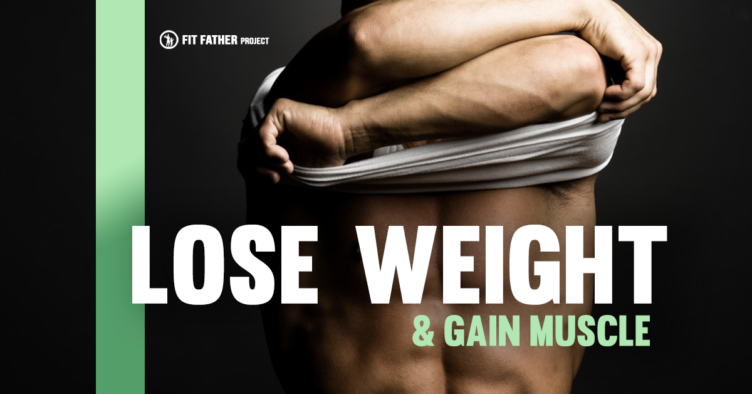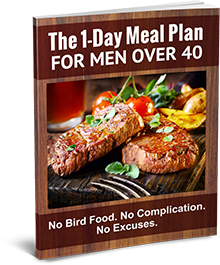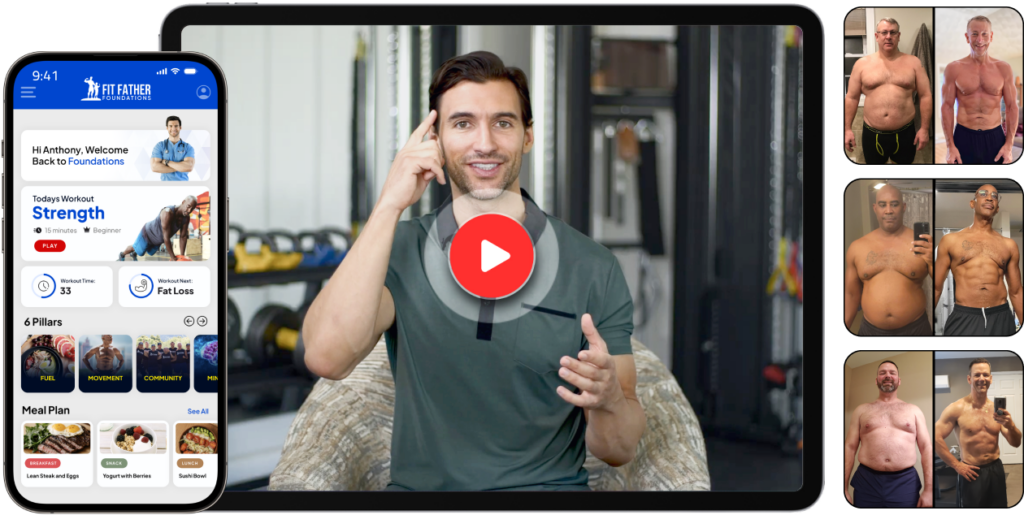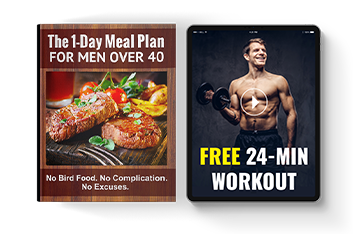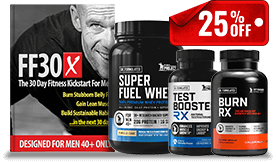If you want to get into the best shape of your life, you're probably wondering how to lose weight and gain muscle.
If you want a chiseled, fit body you need to shed fat without losing lean mass to keep your physique looking great.
It may seem impossible to lose fat and gain muscle at the same time, but the fact is, you just need the right plan to get you there!
By incorporating the proper balance of diet, exercise, and lifestyle changes, you can grow muscles and get that ripped body you've always dreamed of.
Gain Muscle to Lose Fat
If you are overweight, you probably think that it’s because you have too much body fat. While this is true, the other big problem is that you have too little muscle mass.
So, losing fat and gaining muscle really go hand in hand.
Lean muscle mass increases your resting metabolic rate and keeps your body burning fat even at rest.
Plus, strength training will help you not only gain, but also to preserve muscle mass even as you are losing weight.
To lose fat, you need your body to be in a caloric deficit. And to gain muscle, you need a calorie surplus, right?
While that is conventional thinking, there are ways to lose fat while still maintaining, and even gaining, muscle mass.
The Importance of Strength Training
A research study published in Medicine & Science in Sports & Medicine found that the key to losing fat without losing muscle is the combination of both resistance training and cardiovascular training.
When comparing groups that performed either endurance activity versus resistance training versus a combination of both, the combination group was able to lose about 16 pounds of fat while still gaining 10 pounds of muscle!
Increasing lean muscle mass impacts your metabolism!
By increasing your calorie burn with endurance exercises you will lose weight. And by also incorporating strength training, you will be able to increase muscle mass.
But this is just one piece of the puzzle. To lose fat without losing muscle, you need a comprehensive approach that includes exercise, diet, AND lifestyle changes.
By committing to these steps, you will be well on your way to achieving these fitness goals.
How to Lose Weight and Gain Muscle in 8 Steps
1. Do Full-Body Strength Training
In order to build lean body mass, you need to train all of your major muscle groups.
Full bodyweight training is an efficient way to incorporate strength training to lose weight and gain muscle at the same time.
When you start on an exercise program to lose weight, there is the risk of also losing muscle mass. This is why weight training is a vital component of any workout program.
Strength training helps preserve lean body mass. A study performed at the Obesity Research Center at St Luke's-Roosevelt Hospital compared participants that were put either on a diet plus strength training, a diet plus cardio, or a diet alone.
Each of these groups lost about the same amount of fat, however, the strength training group lost significantly less muscle mass than the cardio and diet-only groups.
In fact, the diet and cardio groups lost twice as much muscle mass as those that performed strength training.
This shows that all weight loss is not equal! And to keep that toned, muscular physique, strength training is absolutely necessary.
You should aim for a minimum of two days a week of strength training, and ideally three days.
Studies have shown that the most efficient workout plans involve full-body workouts spread out three times a week as compared to only hitting specific muscles once a week.
If you aren’t sure about what exercises to start with, the free 24 Minute Workout from the Fit Father Project is a great place to start!
Here’s A Free 24-Min Fat Burn Workout For Busy Men 40+
This powerful workout will reignite your metabolism to burn fat 24/7 like you did in your 20s…
2. Perform High-Intensity Interval Training (HIIT)
HIIT is a great cardio option to burn calories in a short amount of time. But it’s not just a cardiovascular benefit you will be getting.
You can do pretty much any exercise you choose during these intervals.
This gives you the opportunity to train multiple muscle groups so that you will build lean muscle while simultaneously burning off fat.
Research from the University of North Carolina has even shown that HIIT is effective at increasing muscle size over a three week period of time.
HIIT will also help you burn calories to shed those extra pounds.
With higher-intensity workouts, you will burn more calories, even after the workout has ended. This is called Excess Post-Exercise Oxygen Consumption, or EPOC for short.
So if you are short on time, the key is to really up the intensity. This ensures that even a workout that is low in minutes will be high in fat burning and strength building.
3. Cut Calories Slowly to Avoid Muscle Loss
So we know that to lose fat, your body has to be in a calorie deficit. And to gain muscle, you need a calorie surplus.
It seems like the two can’t happen together!
If you cut calories to lose weight, it is true that you can lose both fat and muscle. But if you have a well-planned nutrition strategy, you can limit muscle loss while still losing fat. And it is possible to even build more muscle.
The key is to first cut calories back slowly. If you are eating 2,500 calories a day, don’t suddenly drop down to 1,500 calories.
This will ensure you lose muscle. Start with a very small calorie deficit, about 300 or so calories a day. This will limit muscle loss.
4. Eat More Protein
If you want to lose weight and gain muscle, you need to increase your protein intake.
This is essential to do if you want to lose fat without losing muscle.
Protein is a macronutrient that not only builds muscle but also spares muscle mass while you are cutting calories.
A recent study looked at men on low-calorie diets that were also performing resistance training and HIIT six days a week.
Each group consumed the same number of calories, however, the group that consumed a higher protein diet gained more lean muscle mass and lost more fat.
The exact amount of protein you should aim to consume will depend on your specific goals and current weight.
A recent meta-analysis found that muscle-building gains seem to top out at about 1.6 grams per kilogram of body weight.
The authors of this study noted, however, that for those looking to maximize muscle-building gains this number could be increased all the way up to 2.2 grams per kilogram, or about one gram of protein per pound of body weight.
Your calories should come from lean protein sources, such as chicken, lean beef, or fish.
As far as carbs and fat intake, you need to limit processed foods such as those high in sugars and simple starches.
These types of foods will spike your insulin levels and lead to increased weight gain.
In order to lose weight and maintain muscle, you also need to limit foods high in saturated and trans fats.
This does not mean eliminating food groups or “banning” certain foods from your life. It means making smart choices on a daily basis to maximize fat loss.
To get you started, check out the free 1-Day Meal Plan from the Fit Father Project!
Here’s A Free Weight Loss Meal Plan For Busy Men 40+
Discover exactly what to eat for breakfast, lunch, and dinner to lose belly fat & feel energized 24/7 without hard dieting...
5. Eat More Often To Lose Weight and Gain Muscle
Studies have found that spreading your calorie intake out over the course of the day can help you gain muscle and lose weight.
Instead of eating two or three big meals, try to spread this out into five or six smaller meals throughout the day.
Research has shown that by doing this you can lose weight while reducing the loss of lean body mass.
The type of food you eat throughout the day is important, and make sure you spread out your protein intake over the course of the day.
Eating a moderate amount of protein at each meal stimulates muscle protein synthesis more effectively than eating the bulk of your protein at one meal.
6. Make Sleep A Priority
If your body can’t fully recover, you'll never maximize fat loss and muscle gains.
Sleep is just as important as diet and exercise in reaching your full fitness potential.
Sleep deprivation can alter hormone levels, like cortisol, that impact hunger and metabolism.
This, in turn, can have a negative effect on your weight loss goals.
Plus, cortisol is a catabolic hormone, which means that it breaks down protein stores.
High cortisol levels can lead to increased muscle breakdown, which will clearly have a negative impact on your ability to gain muscle.
Not getting adequate sleep can limit fat loss and impair your strength gains even if you are following a proper nutrition and fitness plan.
So despite the fact that you are doing everything right with your workouts and nutrition, you can completely sabotage this with poor sleep habits.
Aim for at least 7-8 hours of sleep every night to maximize your ability to lose fat without losing muscle.
7. Add Well-Researched Supplements to Help With Weight Loss and Muscle Gain
Supplements aren’t necessary to lose fat and gain muscle, but they can help.
There are numerous supplements on the market today, but the best-researched ones to get you started include protein powders and creatine monohydrate.
Whey Protein
Studies using whey protein supplementation have shown increases in muscle protein synthesis, increased muscle mass and strength, improved recovery, and even anti-inflammatory benefits.
Whey protein has been shown to lead to gains in lean body mass over time, which is greater than gains from exercise alone.
The timing of whey protein intake is an important factor in promoting muscle synthesis.
When whey is ingested more immediately following a training session, there is a greater response in muscle protein synthesis.
While eating whole foods is the best way to get your protein intake, supplementation is a practical way of ensuring the intake of adequate protein quality and quantity, while minimizing caloric intake.
Especially when you're on the go and need something quick after a workout!
Casein Protein
Casein is more slowly digested than whey.
This makes casein the preferred supplement in situations when a slow release of nutrients is beneficial.
For this reason, it is often marketed as a supplement to take before bedtime when you will be going 7-10 hours without eating.
Since casein is digested more slowly, it can be thought of as anti-catabolic.
It is beneficial in preventing muscle breakdown when your body is in a fasting states-such as overnight or during a busy day when you have to go long periods without eating.
Creatine Monohydrate
When combined with heavy resistance training, creatine monohydrate has been shown to enhance physical performance, muscle mass, and fat-free mass.
Double-blind studies using more specific muscle measurements have also been done and show that combining creatine supplementation with strength training over several weeks produces greater increases in muscle size compared with strength training alone.
Of all the available supplements on the market today, creatine monohydrate is the most widely studied.
Numerous studies show benefits with supplementation, typically with a loading dose of 15-25 grams a day for about five days followed by a maintenance dose of 5 grams a day.
8. Drink More Water
Maintaining proper hydration is a top priority in fitness, especially when you are trying to lose weight while still gaining muscle mass.
Studies have shown that athletes exercising while under-hydrated have a decrease in resistance training performance.
If you can’t perform strength training at your highest level, you will be unable to maintain muscle mass while still losing weight.
Staying well-hydrated is also crucial for ongoing weight loss.
Studies have shown, that when coupled with good nutrition, drinking enough water can increase weight loss.
In addition, drinking more water throughout the day may also decrease hunger cues and help you cut back on calorie intake as well.
The amount of water to drink each day will vary based on your level of activity.
The easiest way to monitor your hydration status is by the color of your urine — it should be pale or clear colored.
And always remember that the higher your level of activity, the more water you will need throughout the day to replace what is lost in sweat.
Lose Fat and Gain Muscle with the Fit Father Project
Losing fat without while gaining muscle is the ultimate fitness goal.
It takes dedication and commitment but it can be achieved by following the right plan.
There are a lot of programs out there that promise immediate results and quick-fix plans, but the truth is there are no shortcuts when it comes to lifelong health and fitness.
In order to lose fat and gain muscle, you will need to be serious about making lifestyle changes for the long run.
I can promise you that you will be well on your way to shedding those pounds and building a muscular physique if you can follow the steps above.
And if you need more motivation, there is an awesome team of trainers, nutritionists, and doctors at the Fit Father Project that will be there every step of the way to help you achieve these goals.
There are also a number of fitness programs and articles offered by the Fit Father Project that can help you along the way.
But it’s not just about the programs themselves; it's about the people that will be there to push you as you work towards your goals.
So start today and transform your body through weight loss and muscle gain, and get into the best shape of your life!
Holly is board-certified in nephrology and internal medicine, has a bachelor’s degree in dietetics, and is a certified personal trainer with NASM-PES certification. Holly is a keen runner, triathlete, and fitness and nutrition enthusiast. She has completed four full ironmans, twelve marathons, countless half ironmans, Olympic distance triathlons, half marathons, and numerous other road races. Holly joined the Fit Father Project in May 2019 as a regular writer, contributing articles on health, wellness, exercise, and nutrition. The FOUNDATIONS Program is created by Dr. Anthony Balduzzi for Men 40+ who want Lifelong Health. In just 6-Weeks following FOUNDATIONS, you'll experience: FOUNDATIONS has transformed 60,000 lives! Are you ready to experience true lasting health & results?![]()
Holly Smith, M.D., B.S. Dietetics, NASM-PES Certified Trainer
Writer, Fit Father ProjectJoin our 6-Week Doctor Designed Health Program. You'll Gain Foundational Health for the Rest of Life.

